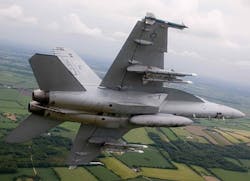F/A-18E/F contract brings DOD aircraft orders this week to 25 in deals worth $2.2 billion
PATUXENT RIVER NAS, Md., 26 Jan. 2012. U.S. Department of Defense (DOD) military aircraft purchases continued to roll along on Wednesday, with a U.S. Navy order of 15 Boeing F/A-18E/F Super Hornet carrier-based jet fighter-bombers under terms of a $687.5 million contract modification. Wednesday's order brings this week's DOD combat aircraft orders to 25 in three separate deals collectively worth nearly $2.2 billion.
U.S. Naval Air Systems Command at Patuxent River Naval Air Station, Md., Wednesday ordered 14 F/A-18E single-seat strike fighters and one F/A-18F two-seat fighter bombers from The Boeing Co. (NYSE:BA) Defense, Space & Security segment in St. Louis. The Super Hornet has an internal 20-millimeter gun and can carry air-to-air missiles, air-to-ground missiles, and a wide variety of bombs. The aircraft represents the primary jet fighter and ground-attack capability for Navy carrier battle groups.
On Tuesday the Navy ordered five E-2D Advanced Hawkeye carrier-based maritime patrol and surveillance early warning aircraft from the Northrop Grumman Corp. (NYSE:NOC) Aerospace Systems segment in Bethpage, N.Y., in a $781.5 million contract modification, and on Monday the U.S. Air Force ordered five C-17 Globemaster III military cargo jets in a $693.4 million contract modification.
The twin-engine F/A-18E/F multirole fighter aircraft are larger and more advanced derivatives of the F/A-18C and D Hornet strike fighter. The aircraft also can act as a carrier-based airborne tanker by adding an external air refueling system. The F/A-18 aircraft, which has been in the Navy inventory since the early 1980s was designed to replace the A-6 Intruder and A-7 Corsair carrier-based bombers, as well as the F-4 Phantom jet fighter. Ultimately the F/A-18 also replaced the Navy's fleet of F-14 Tomcat jet fighters.
The Super Hornet advanced F/A-18 models first flew in 1995. Full-rate production began in 1997, and entered Navy service in 1999. The Royal Australian Air Force (RAAF), which has operated the F/A-18A as its main fighter since 1984, ordered the F/A-18F in 2007 to replace its aging F-111 fleet. RAAF Super Hornets entered service in December 2010.
The Super Hornet avionics has a touch-sensitive, up-front control display; large liquid crystal multipurpose color display; quadruplex digital fly-by-wire system and digital flight-control system that detects and corrects for battle damage. The aircraft has the APG-79 active electronically scanned array (AESA) radar; Advanced Targeting Forward Looking InfraRed (ATFLIR) electro-optical sensor system; and the AN/AR-210 VHF/UHF radio and a MIDS low volume terminal for HAVE QUICK, SINCGARS, and Link 16 radio communications.
The F/A-18F also is receiving an aft cockpit Joint Helmet Mounted Cueing System (JHMCS) that provides multi-purpose aircrew situational awareness including high-off-bore-sight cuing of the AIM-9X Sidewinder air-to-air missile. The aircraft's Shared Reconnaissance Pod (SHARP) is a high-resolution, digital tactical air reconnaissance system day/night and all-weather capability.
This week's F/A-18E/F buy is part of the Navy's Lot 36 procurement, and brings the number of F/A-18E aircraft on this contract from 55 to 69, and on the F/A-18F contract from 20 to 21. Boeing will do the work in St. Louis; El Segundo, Calif.; Hazelwood, Mo.; Cleveland; Torrance, Calif.; Vandalia, Ohio; Ajax, Ontario; Irvine, Calif.; Johnson City, N.Y.; and Grand Rapids, Mich., and should be finished by late 2014.
For more information contact Boeing Defense, Space & Security online at www.boeing.com/bds, or Naval Air Systems Command at www.navair.navy.mil.
